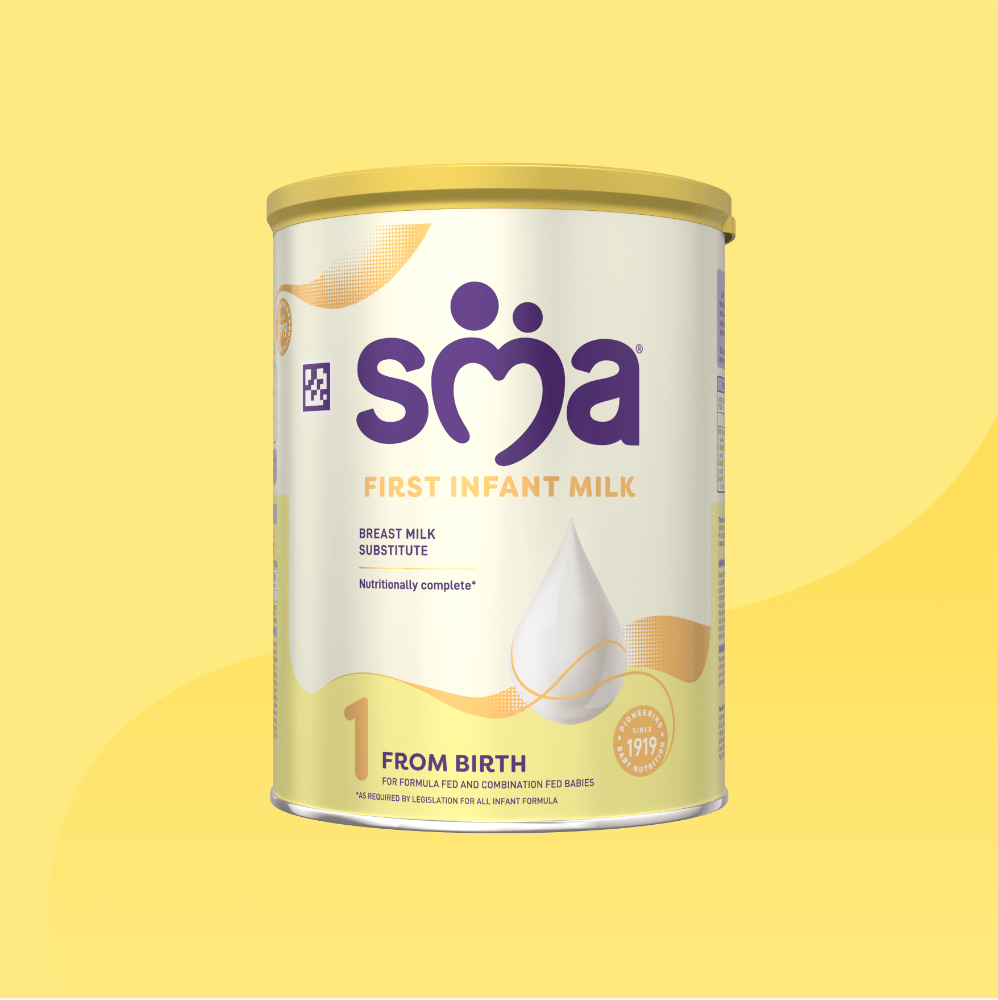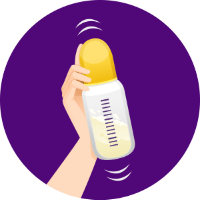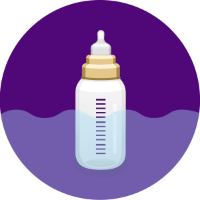SMA® First Infant Milk
A whey dominant, nutritionally complete* infant milk suitable from birth. It can be used for infants who are not being breastfed or for those being combination fed.
Comparison chart
SMA® First Infant Milk in comparison with Aptamil, Cow & Gate, HiPP Organic and Kendamil first infant milks.
POWDER ONLY
| SMA® PRO First Infant Milk1 | Aptamil Advanced14 | Aptamil First Infant Milk10 | Cow & Gate First Infant Milk15 | HiPP Organic First Infant Milk16 | Kendamil First Infant Milk17 | |
|---|---|---|---|---|---|---|
| Protein levels per 100 ml | 1.24 g | 1.3 g | 1.3 g | 1.3 g | 1.25 g | 1.3 g |
| Protein (whey:casein) ratio** | 70 : 30 | 60 : 40 | 50 : 50 | 60 : 40 | 60 : 40 | 60 : 40 |
| Meta-analysis demonstrating growth comparable to WHO growth standards1 | ||||||
| Contains 2'FL |
** HSE recommends a whey-based formula in the first year of life for formula fed infant
Clinical evidence
A Meta-analysis published in AJCN concluded that infants fed on a whey-dominant formula with an amino acid profile closer to breast milk demonstrated growth comparable to WHO growth standards9
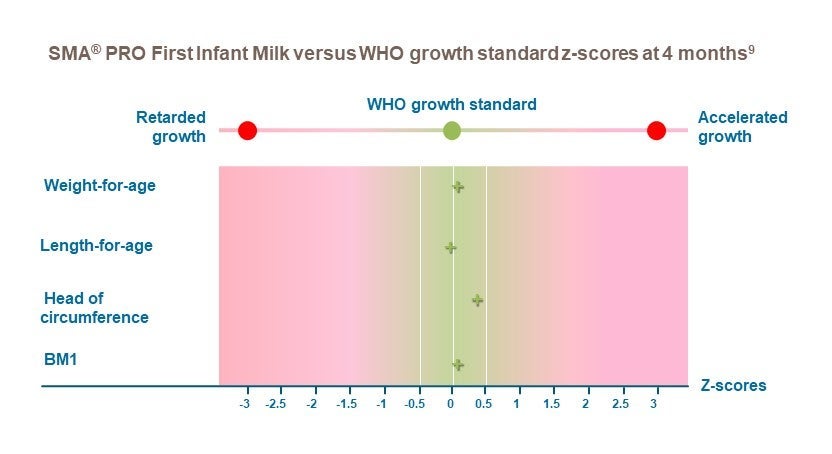
Chart 1. Green crosses represent average growth measurements in infants fed SMA® First Infant Milk compared with WHO growth standards. All measurements fall within ±0.5 standard deviation.
SMA® First Infant Milk is supported by a meta-analysis demonstrating that weight-for-age, length-for-age, head circumference and BMI were all within 0.5 standard deviation of the WHO growth standard.9
Better amino acid profile compared to Aptamil First Infant milk as demonstrated in the graph below10
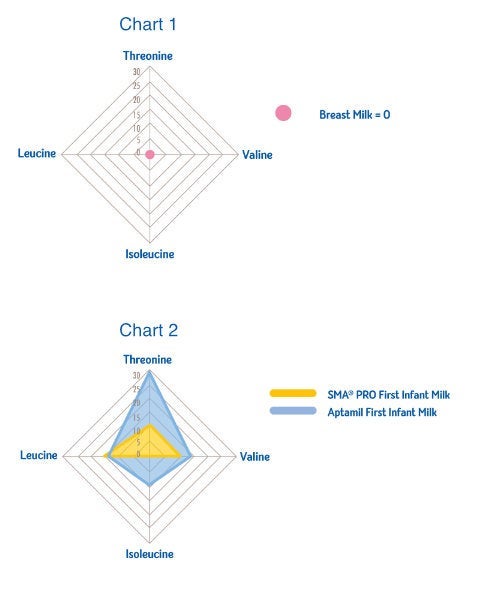
Available evidence from The Childhood Obesity Project Study, a large independent Randomised Controlled Trial (RCT), suggests that higher protein intakes increase plasma and tissue levels of insulin-releasing amino acids and of insulin and insulin-like growth factor 1 (IGF-1), and thereby increase weight gain and adipogenic activity.11,12
Chart 1: Spider graph represents the amino acid profile of breast milk.
Chart 2: Spider graph represents the insulinogenic amino acid percentage difference in each formula (SMA® PRO First Infant Milk and Aptamil First Infant Milk)10,13.
* As required by the legislation for all infant formula.
** Whey based formulas are recommended by the FSAI, HSE, NHS and UNICEF
2'FL, 2'-Fucosyllactose
Data cards
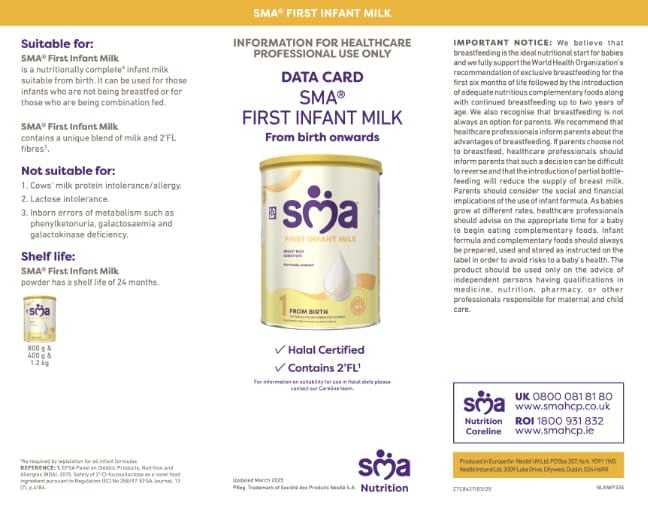
Download the powder format data card
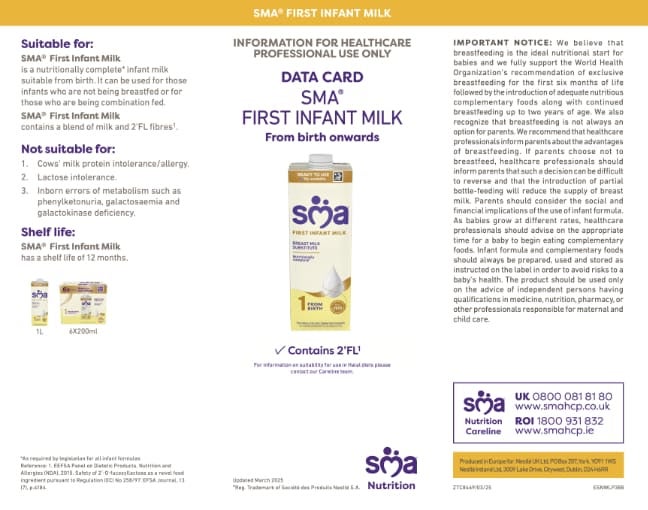
Download the 200 ml and 1 litre liquid format data card
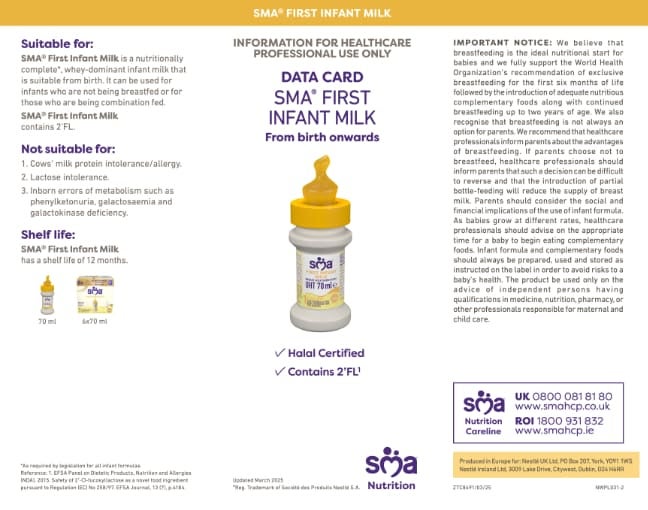
Download the 70 ml Hospital Bottle and Starter Pack data card
Product details
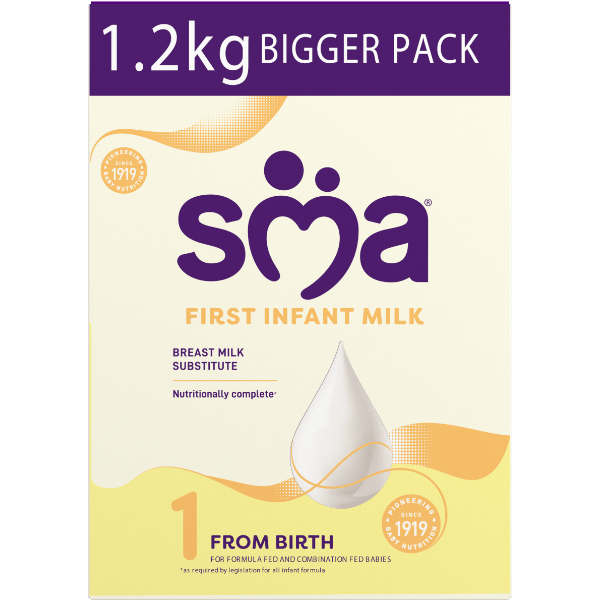
SMA® First Infant Baby Milk Powder Formula
1.2kg Powder
Use product within 4 weeks of opening. Approximately 279 scoops per box.
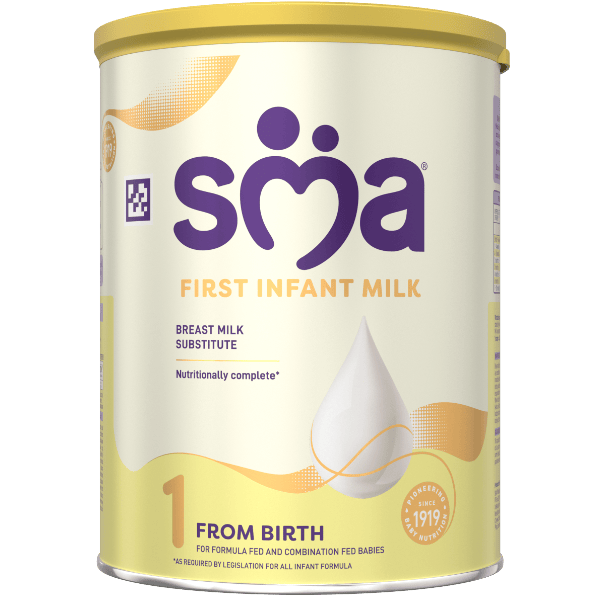
SMA® First Infant Baby Milk Powder Formula
800g Powder
Easy open lid. Scoop can be stored in suspension inside the can. Use product within 4 weeks of opening. Approximately 186 scoops per can.
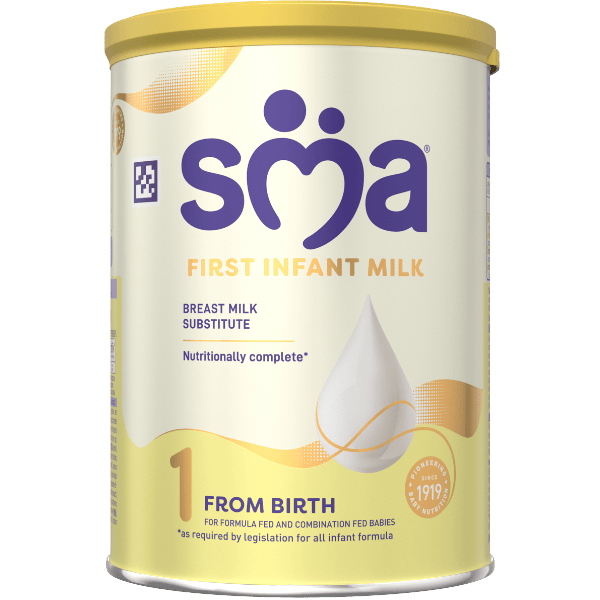
SMA® First Infant Baby Milk Powder Formula
400g Powder
Easy open lid. Use product within 4 weeks of opening. Approximately 93 scoops per can.
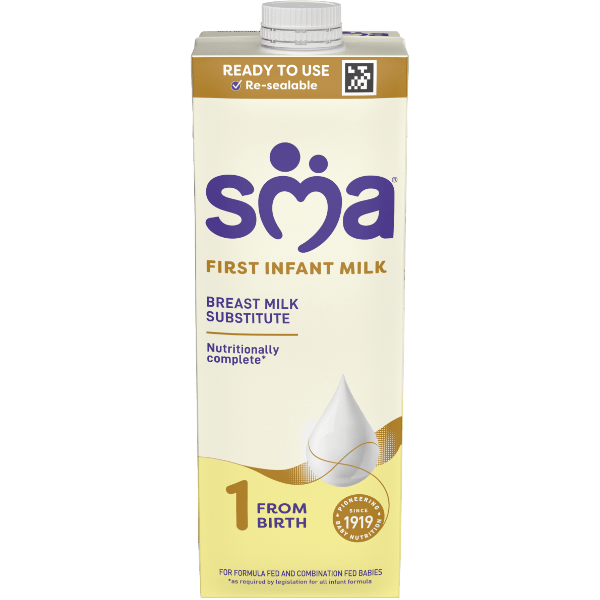
SMA® First Infant Milk Ready to Drink
1 Litre Resealable Carton
Ready to use liquids do not require any preparation, just shake and pour into a sterilised bottle. Easy to pour and can be kept in the fridge for up to 48 hours after opening.
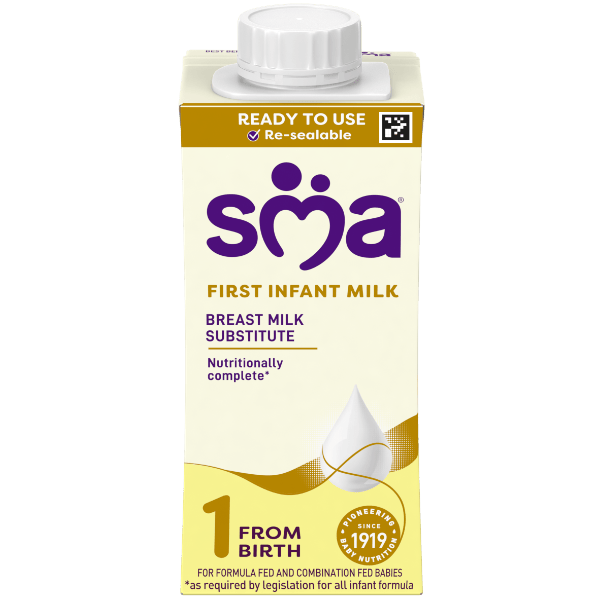
SMA® First Infant Milk Ready to Drink
200ml Resealable Carton
Ready to use liquids do not require any preparation, just shake and pour into a sterilised bottle. 200 ml on-the-go resealable cartons are easy to pour and can be kept in the fridge for up to 24 hours after opening.
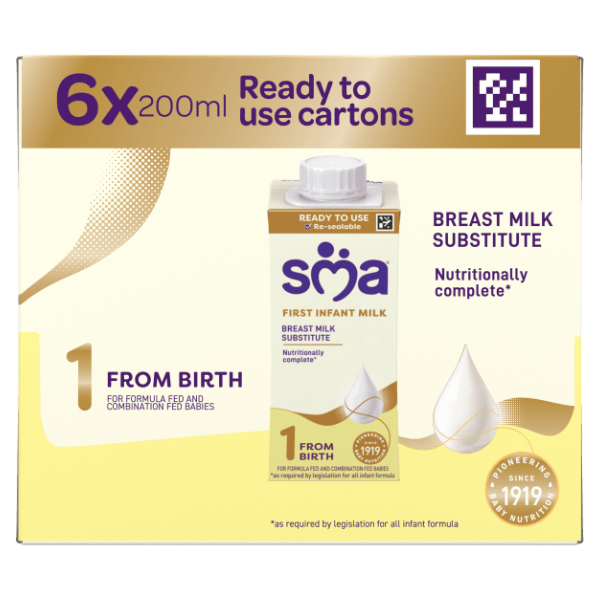
SMA® First Infant Milk Ready to Drink
6 x 200ml Resealable Carton Multipack
Ready to use liquids do not require any preparation, just shake and pour into a sterilised bottle. Contains 6 x 200 ml on-the-go resealable cartons. Easy to pour and can be kept in the fridge for up to 24 hours after opening.
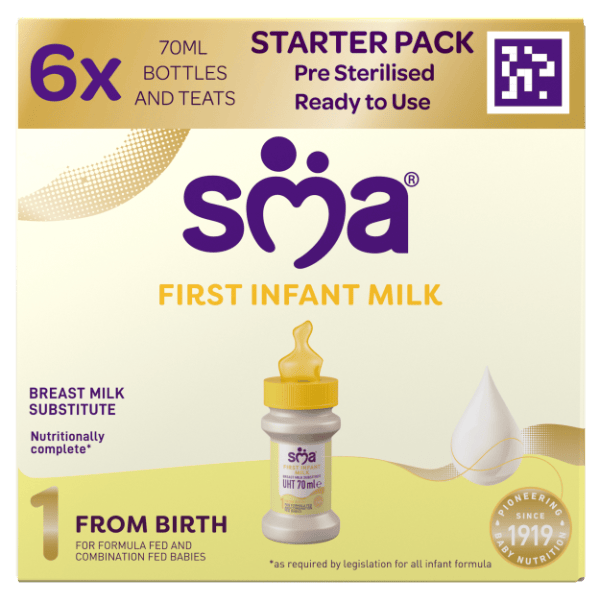
SMA® First Infant Milk Starter Pack with NUK® Orthodontic Teats
6 x 70ml Resealable Bottles
Ready to use liquids do not require any preparation, just shake and screw the pre-sterilised teat straight on to the bottle. Contains 6 x 70 ml plastic bottles with 6 NUK® pre-sterilised orthodontic teats. Warning: teats contain latex.
(Available in UK only)

SMA® First Infant Milk 70 ml Hospital Bottle
For hospital use only
NHS catalogue code (UK only): ABT082
United Drug Wholesale order code (Ireland only): 12600991
Powdered Milk
Birth - 12 months
| Approx. age of baby | Approx. weight of baby | Preparation for single feeds | Cooled, freshly boiled water | Feeds in 24 hrs |
|---|---|---|---|---|
| ||||
| kg | Level scoops | ml | ||
| Birth – 2 weeks | 3.4 | 3 | 90 | 6 |
| 2 – 4 weeks | 3.7 | 4 | 120 | 6 |
| 4 – 8 weeks | 4.2 | 4 | 120 | 6 |
| 2 months | 5.3 | 5 | 150 | 5 |
| 3 months | 6.1 | 6 | 180 | 5 |
| 4 months | 6.7 | 6 | 180 | 5 |
| 6 months | 7.6 | 8 | 240 | 4 |
| 7 – 12 months | - | 7 | 210 | 3 |
| Approx. age of baby | Approx. weight of baby | Preparation for single feeds | Cooled, freshly boiled water | Feeds in 24 hrs |
|---|---|---|---|---|
| ||||
| lb | Level scoops | fl. oz. | ||
| Birth – 2 weeks | 7 ½ | 3 | 3 | 6 |
| 2 – 4 weeks | 8 | 4 | 4 | 6 |
| 4 – 8 weeks | 9 ¼ | 4 | 4 | 6 |
| 2 months | 11 ¾ | 5 | 5 | 5 |
| 3 months | 13 ½ | 6 | 6 | 5 |
| 4 months | 14 ¾ | 6 | 6 | 5 |
| 6 months | 16 ¾ | 8 | 8 | 4 |
| 7 – 12 months | - | 7 | 7 | 3 |
This table is a guide only; a baby may need more or less than the volumes stated. Caregivers should consult their healthcare professional if more advice is needed. Remember, a baby should be fed on demand. Mix 1 scoop of powder to 30 ml (approx. 1 fl. oz.) of water.
Approx. 186 scoops per can. 1 scoop = 4.3 g
Ready to drink liquid milk
Birth - 12 months
| Approx. age of baby | Approx. weight of baby | Size of feed | Feeds in 24 hrs | |
|---|---|---|---|---|
| ||||
| kg | ml | |||
| Birth – 2 weeks | 3.4 | 100 | 6 | |
| 2 – 4 weeks | 3.7 | 130 | 6 | |
| 4 – 8 weeks | 4.2 | 130 | 6 | |
| 2 months | 5.3 | 170 | 5 | |
| 3 months | 6.1 | 200 | 5 | |
| 4 months | 6.7 | 200 | 5 | |
| 6 months | 7.6 | 250 | 4 | |
| 7 – 12 months | - | 200 | 3 | |
| Approx. age of baby | Approx. weight of baby | Size of feed | Feeds in 24 hrs | |
|---|---|---|---|---|
| ||||
| lb | fl. oz. | |||
| Birth – 2 weeks | 7½ | 3½ | 6 | |
| 2 – 4 weeks | 8 | 4½ | 6 | |
| 4 – 8 weeks | 9¼ | 4½ | 6 | |
| 2 months | 11¾ | 6 | 5 | |
| 3 months | 13½ | 7 | 5 | |
| 4 months | 14¾ | 7 | 5 | |
| 6 months | 16¾ | 8½ | 4 | |
| 7 – 12 months | - | 7 | 3 | |
This table is a guide only; a baby may need more or less than the volumes stated. Caregivers should consult their healthcare professional if more advice is needed. Remember, a baby should be fed on demand.
SMA® First Infant Milk powder – 800 g and 400 g can
- Do not add extra powder or water to make the feeds stronger or weaker and do not press powder into scoop. Using too much or too little powder can make your baby ill.
- We recommend preparing each feed in individual bottles when required.
- For hygienic reasons, discard unfinished feed in the bottle as soon as possible.
- For older babies, made-up formulae can be added to food.
- Do not alter or add to formulae unless medically directed.
- Do not warm feeds in a microwave, hot spots may occur and cause scalding.
- Remember, cows’ milk should not be used as a drink during the first year.
SMA® First Infant Milk Starter Pack – 70 ml bottle
- Special Safety Feature – Reject bottle if the foil under cap is missing or damaged prior to opening.
- Check best before date.
- After opening use immediately or store in the fridge (5 ºC or below) for up to 24 hours.
- For hygienic reasons, discard unfinished feed as soon as possible, and always within 1 hour.
- After use, discard bottle, teat and remaining contents. Bottles and teats are for single use only.
- Do not alter or add to formulae unless medically directed.
- Do not microwave, hot spots may occur and cause scalding.
- Remember, cows' milk should not be used as a drink during the first year.
- Do not freeze.
Important teat information for the child’s safety and health – WARNING!
- Teats are produced from natural rubber latex which may cause allergic reactions.
- Disposable teat (for single use only).
- This NUK® disposable orthodontic pre-sterilised teat is a size 1 teat (appropriate for babies from 0–6 months) with a feed hole suitable for infant milk. Use with SMA® First Infant Milk 70 ml bottles.
- Give your baby’s feed only in the quantities and concentrations recommended by the manufacturer.
- Always check the food temperature before feeding.
- Always use this product with adult supervision.
- Continuous and prolonged sucking of fluids may cause tooth decay.
- Never use feeding teats as a soother.
- Teat expiry date: See individual teat.
- Do not dip in medicine.
- The NUK® disposable orthodontic pre-sterilised teat (manufactured for SMA® Nutrition) conforms to the requirements of EN14350.
SMA® First Infant Milk liquid – 1 litre Tetra-Pak®
- Check best before date.
- Once open, reseal carton and store only in the fridge (5 ºC or below). Consume within 48 hours.
- For hygienic reasons, discard unfinished feed in the bottle as soon as possible, and always within 1 hour.
- For older babies, ready to use formulae can be added to food.
- Do not alter or add to formulae unless medically directed.
- Do not warm feeds in a microwave, hot spots may occur and cause scalding.
- Remember, cows' milk should not be used as a drink during the first year.
- Do not freeze.
SMA® First Infant Milk liquid – 200 ml Tetra-Pak
- Check best before date.
- Once open, reseal carton and store only in the fridge (5 ºC or below). Consume within 24 hours.
- For hygienic reasons, discard unfinished feed in the bottle as soon as possible, and always within 1 hour.
- For older babies, ready to use formulae can be added to food.
- Do not alter or add to formulae unless medically directed.
- Do not warm feeds in a microwave, hot spots may occur and cause scalding.
- Remember, cows' milk should not be used as a drink during the first year.
- Do not freeze.
Preparation
How to prepare the baby's feed - powder
Whilst this product is made under strict hygienic conditions, it is not sterile. Failure to follow instructions on preparation and storage may make the baby ill.
How to prepare the baby's feed - (70 ml bottle Ready to drink)
Failure to follow instructions may make the baby ill.
How to prepare the baby's feed - (1 litre & 200 ml Ready to drink)
Failure to follow instructions may make the baby ill.
- FSAI. 2012. Best Practice for Infant Feeding in Ireland. Available from: https://www.fsai.ie/publications_infant_feeding/ [Accessed 7th February 2023].
- HSE. 2023. Types of formula. Available from: https://www2.hse.ie/babies-children/bottle-feeding/types-formula/ [Accessed 7th February 2023].
- NHS. 2023. Types of formula. Available from: https://www.nhs.uk/conditions/baby/breastfeeding-and-bottle-feeding/bottle-feeding/types-of-formula/ [Accessed 7th February 2023].
- Unicef. 2014. A guide to infant formula for parents who are bottle feeding. Available from: Health professionals' guide to infant formula (unicef.org.uk) [Accessed 2nd March 2023].
- Goehring KC et al. Similar to Those Who Are Breastfed, Infants Fed a Formula Containing 2’- Fucosyllactose Have Lower Inflammatory Cytokines in a Randomized Controlled Trial J Nutr. 2016;146:2559–2566.
- WHO Multicentre Growth reference Study group Acta Paediatr Suppl 2006; 450: 71H15.
- Baird J et al Being big or growing fast: systematic review of size and growth in infancy and later obesity BMJ 2008; 331: 929.
- Kramer MS et al Feeding effects on growth during infancy J Pediatr 2004; 145:500–505
- Alexander DD et al. Growth of infants consuming whey-predominant term infant formulas with a protein content of 1.8g/100kcal: a multi-center pooled analysis of individual participant data. Am J Clin Nutr 2016; 104: 1083–1092
- Aptamil First Infant milk (800g pack) (nutricia.co.uk) accessed January 2024
- Koletzko et al Lower Protein in infant formula is a ssociated with lower weight up to 2y: a randomized clinical trial. Am J Clin Nutr 2009; 89: 1836–45.
- 1Weber M et al Lower protein content in infant formula reduces BMI and obesity risk at school age: follow-up of a randomized trial Am J Clin Nutr 2014;99:1041–51.
- Nestle data on file, 2018: Batch analysis of amino acid composition in SMA PRO First Infant Milk, Human Milk and Aptamil First Infant Milk, 2018
- Aptamil Advanced First Infant Milk datacard. Available at: www.nutricia.co.uk/hcp/pim-products/aptamil-advanced-first-infant-milk-powder.html (Accessed January 2024)
- Cow & Gate First Infant Milk datacard. Available at: www.nutricia.co.uk/hcp/pim-products/cow-gate-first-infant-milk-powder.html (Accessed January 2024)
- HIPP Organic First Infant Milk datacard. Available at: www.hipp.co.uk/healthcare-professionals/ (Accessed January 2024)
- Kendamil First Infant Milk datacard. Available at: https://hcp.kendamil.com/product/classic-first-infant-milk-800g/# (Accessed January 2024)
*2'FL: structurally identical human milk oligosaccharides, not sourced from breast milk
IMPORTANT NOTICE:
The World Health Organisation (WHO) has recommended that pregnant women and new mothers be informed on the benefits and superiority of breastfeeding – in particular the fact that it provides the best nutrition and protection from illness for babies. Mothers should be given guidance on the preparation for, and maintenance of, lactation, with special emphasis on the importance of a well-balanced diet both during pregnancy and after delivery. Unnecessary introduction of partial bottle-feeding or other foods and drinks should be discouraged since it will have a negative effect on breastfeeding. Similarly, mothers should be warned of the difficulty of reversing a decision not to breastfeed. Before advising a mother to use an infant formula, she should be advised of the social and financial implications of her decision: for example, if a baby is exclusively bottle-fed, more than one can (400 g) per week will be needed, so the family circumstances and costs should be kept in mind. Mothers should be reminded that breast milk is not only the best, but also the most economical food for babies. If a decision to use an infant formula is taken, it is important to give instructions on correct preparation methods, emphasising that unboiled water, unsterilised bottles or incorrect dilution can all lead to illness.

